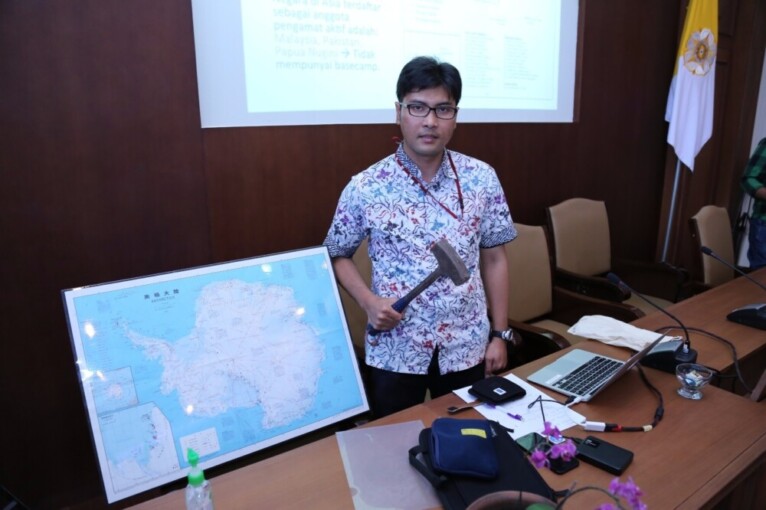
A geologist from Universitas Gadjah Mada (UGM), Nugroho Imam Setiawan, Ph.D. had succeeded in finishing a research expedition in Antarctica. Nugroho was the first UGM researcher, as well as ASEAN representative, who received the opportunity to join an expedition to carry out research into the Earth’s future condition in the Antarctic which was staged by the Japan Antarctic Research Expedition (JARE).
Nugroho, a lecturer at the Geology Engineering Department, recounted his experience after coming back from his expedition which took over four months starting 27 November 2016 and finishing 22 March 2017. The 58th JARE Expedition had 80 members and 50 of them were researchers. This research was divided into 10 topics, including meteorology, atmosphere, terrestrial biology, oceanography, geophysics, geodesy, and geology.
“I was included in the geology team which had 8 members. We conducted a geological survey in Antarctica for about 30 days,” said Nugroho on Thursday (29/3) at UGM Head Office.
Nugroho said that each member in the geology team had a main job. He was in charge of observing the weather and recording it twice a day.
At that time, the conditions in Antarctica were entering summer thus the sun shone for 24 hours per day. Meanwhile, the air temperature was about -5 degrees Celsius at night and -2 degrees Celsius at noon, while the maximum temperature was 2 degrees Celsius.
Nugroho said his team routinely collected metamorphic rock samples at the research location every day. There were 8 collection points during their geological survey namely Akebono, Akarui, Tenmodai, Skallevikhalsen, Rundvageshtta, Langdove, West Ogul, and Mt. Riiser Larsen.
“We tried to uncover metamorphic rock, the oldest rock in the Earth which has been in Antarctica for 3.8 billion years,” said Nugroho.
During the expedition, Nugroho found two kinds of rock in the research area. Most of the samples were metamorphic and granitic rocks or the unification of them which is called migmatite. A honeycomb structure is often found in these rocks. This structure is formed by the wind in tyhe dry climate blowing on the rock surface.
While they were in the survey area, Nugroho and his team collected between 10 and 20 kilograms of rock samples. During their survey, they succeeded in collecting more than 3 tons of metamorphic rock.
“There are 141 samples of metamorphic rock weighing 200 kilograms which will be delivered to Indonesia in May,” he added.
Nugroho will conduct advanced research on those rocks. He hopes his research can be beneficial for studying the history of the Earth formation and the evolution of the Earth.
Meanwhile, UGM Rector, Prof. Ir. Dwikorita Karnawati, M.Eng., Ph.D. congratulated Nugroho Imam Setiawan and expressed appreciation for his research. She felt proud of his achievement. UGM succeeded in being trusted to join the research expedition to Antarctica to uncover the Earth’s history.
“We hope Nugroho can inspire other young researchers to dare to enhance their research innovation,” said Prof. Dwikorita.


